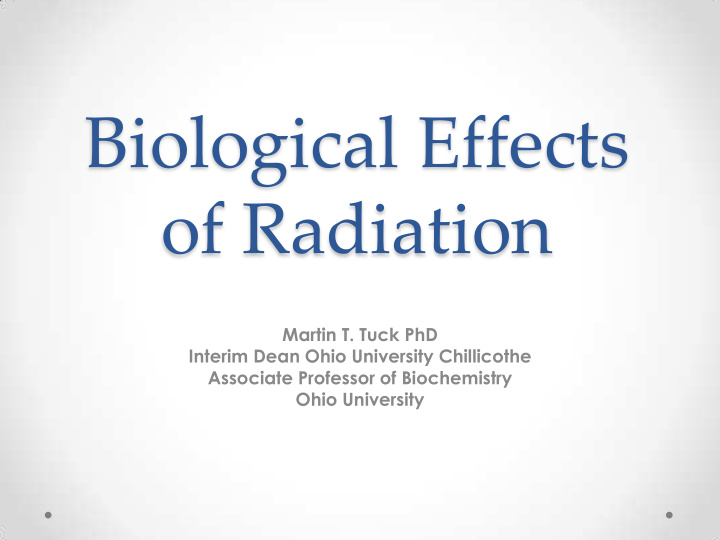



Biological Effects of Radiation Martin T. Tuck PhD Interim Dean Ohio University Chillicothe Associate Professor of Biochemistry Ohio University
What is radioactivity?
The Bohr Atom
Certain elements or atoms of an element are radioactive These radioactive atoms are called radioisotopes, a type of • isotope. Isotopes have an imbalance between the protons and • neutrons within the nucleus. Isotopes are atoms with the same atomic number but different • atomic weight. Radioisotopes are unstable isotopes and achieve stability by • emitting: o Beta particle o Alpha particle o Gamma ray This is called Radioactive decay which can sometimes • damage cells/tissues through damage to the cell’s DNA
Types of Radioactive Decay
Decay is how the radioisotope becomes stable At each decay step usually the atomic weight and sometimes the atomic number decreases
What harm can the radioisotope decay cause? • Radiation Poisoning • Mutations • Cancer
Decay of radioisotopes results in damage to DNA
Good Radiation
What radioisotopes are found at the Piketon Plant ?? • According to the U.S. Department of Energy Portsmouth Annual Environmental Report (2009) • Uranium-234 (0.8% of total uranium) • Uranium-235 (5.2%) • Uranium-238 (94%) • Technetium-99 • Other radioisotopes are present in very small amounts and would be present anywhere in the world.
Why are there 3 uranium isotopes at the Piketon location ? • The plant, a Gas Diffusion Plant, was built to enrich uranium. • What does this mean and why do it?
Where do the radioisotopes end up? • Air • Soil • Water • Food
Should I be concerned about living close to the atomic plant ?? • Radioactivity is measured in a number of ways. Radiation exposure is measured in millirem (mrem). • The average individual receives an annual dose of 311 mrem • Air emission sources measured in 2009 was around 0.020 mrem/year, 15,500 fold less than the radiation exposure you would receive normally. • Similar data has been collected from the soil, water and food sources. • Bottom line-Radiation exposure near the Piketon Plant is virtually no different than any other regional of the country.
Wrap Up, What have we learned? • A sample that is radioactive contains atoms of an element which are radioisotopes. • Radioisotopes emit particles or photons in order to achieve stability, this could occur over millions of years. • The particles/photons can result in the death of cells typically through the damage to the cell’s DNA. • The Piketon Atomic Plant was used to enrich Uranium for the 235 isotope used in nuclear fission reactions. • The area around the atomic plant has proven to be no more harmful then any other area.
Recommend
More recommend